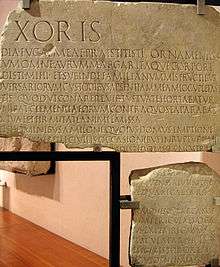Laudatio Turiae

Laudatio Turiae ("In praise of Turia") is a tombstone engraved with a carved epitaph that is a husband's eulogy of his wife.[1] It was made in the late 1st century BC. It portrays the love of a husband for his loyal wife.
This inscription is traditionally known as the "Laudatio Turiae".[2][3] The attribution is uncertain, but the addressee was generally identified with Turia,[4][5] whence the name of the inscription. W. Ward Fowler states, "...there is a very strong probability that her name was Turia, and that he was the certain Q. Lucretius Vespillo..."[6] This assignment is no longer generally accepted.[7]
Tombstone
The frequently moving eulogy inscribed on the stone is addressed from a husband to his deceased wife, lauding her virtues, self-sacrificing love, and unflinching loyalty toward him when she was still alive. The stone itself is broken, and parts have been found scattered around the city of Rome, although some sections remain lost.[8] At 180 lines, the "Laudatio Turiae" is currently the longest surviving personal inscription from Classical Rome.
Inscription
The inscription gives a unique insight into the late 1st century Roman world during the rise of Augustus Caesar, as its extended history of "Turia's" life addresses many aspects of the Roman society. "Turia's" selfless deeds in defense of her persecuted husband range from sending him jewelry and money when he was in exile to offering him a divorce so he could have an heir—she was unable to bear children. Her husband also lovingly describes her virtues, among which he includes weaving, obedience, faithfulness to family, and religious purity. According to the inscription, her first accomplishment worthy of praise was avenging her parents’ murder, which gives a rather surprising look into the roles of women within the family and society. The husband also says the marriage was unusual, because it lasted forty years with her dying first while he was much older.
Identities
The extant remains of the Laudatio Turiae are missing the fragmented piece that contains the identities of both the husband and wife, thus their names remain unknown. However, studies based on comparison with the histories of Valerius Maximus (6, 7, 2) and Appian (Bell.civ. 4, 44) indicate that the husband and author is Quintus Lucretius Vespillo, consul in 19 BC, married to Turia. Turia is reported to have saved her husband in much the same way described in the inscription, and so it seems probable that they are one and the same, although some scholars reject this assumption.
Location
The Laudatio Turiae is currently housed in the Museo Nazionale Romano at the Terme di Diocleziano Baths of Diocletian in Rome.
See also
Notes
- ↑ Private Lives and Public Personae University of Tennessee
- ↑ http://www.u.arizona.edu/~afutrell/survey/laud%20tur.htm
- ↑ Laudatio Turiae tombstone
- ↑ Women in Rome
- ↑ A funeral eulogy. Rome, 1st cent. B.C. (ILS 8393. Tr. E. Wistrand. L)
- ↑ Social life at Rome in the Age of Cicero by W. Warde Fowler
- ↑ Badian, Ernst (1996). Hornblower, Simon; Spawforth, Antony, eds. Oxford Classical Dictionary (3rd ed.). Oxford: Oxford University Press. p. 822. ISBN 0-19-866172-X.
...has traditionally been assigned to this Turia, but this is now generally rejected and there are no good arguments for the identification.
- ↑ JSTOR: A New Fragment of the Laudatio Turiae
References
- "Civil War." Appian
- Appian, Book IV English
- "Book VI, Chapter VII." Valere Maxime
- Valère Maxime, Book VI, Chapter VII Latin
- The Roman Law Library by Professor Yves Lassard and Alexandr Koptev
- Gordon, A.E., "A New Fragment of the Laudatio Turiae" AJA 54 (1950) 223-226
- Horsfall, N., "Some Problems in the Laudatio Turiae" Bull. Inst. Clas. Stud. 30 85-98
- Wistrand, Erik, The so-called Laudatio Turiae (Berlingska Boktryckeriet, 1976) ISBN 91-7346-009-5